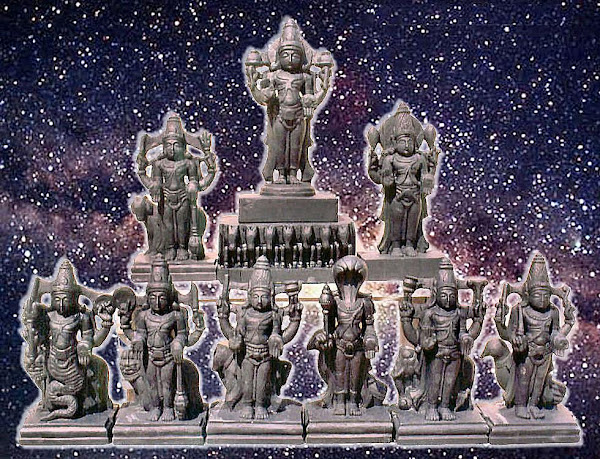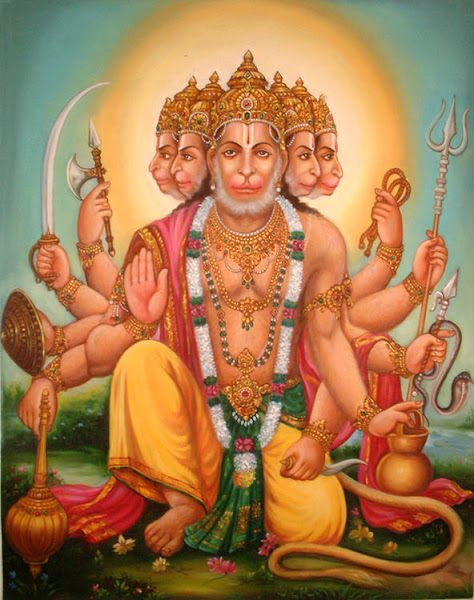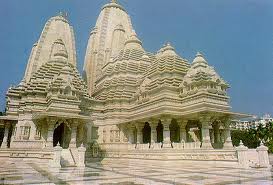Play Bhajagovindam - by M.S. M.Subbulakshmi listen and read carefully line by line. Bhaja govindam
BHAJA GOVINDAMbhaja govindam bhaja govindam
bhaja govindam müãhamate,
samprápte sannihite kále
na hi na hi rakúati dukøòkaraïe.(1)
Adore the Lord, adore the Lord, adore the Lord, O fool! when the appointed time (for departure) comes, the repetition of grammatical rules will not, indeed, save you.
müãha jahèni dhanágamatøúïám
kuru sadbuddhim manasi vitøúïám,
yal-labhase nijakarmopáttam
vittam tena vinodaya cittam.(2)
O fool! leave off the desire for accumulation of wealth; create in the mind, thoughts about Reality, devoid of passion. What you get - i.e. what you have achieved through your past deeds - with that, satisfy your mind.
nárèstanabharanábhèdeùam
døúûvá má gá moháveùam,
etan-mámsavasádi-vikáram
manasi vicintaya váram váram.(3)
Seeing the seductive female form, do not fall prey to frenzied delusion. That (female form) is (but) a modification of flesh and fat. Think well thus in your mind and again and again.
nalinèdalagatajalam atitaralam
tadvaj-jèvitam atiùayacapalam,
viddhi vyádhy-abhimána-grastam
lokam ùokahatam ca samastam.(4)
The water on the lotus-leaf is very unsteady; so also is life extremely unstable. Know that the entire world is devoured by disease and conceit, and smitten with sorrow.
yávad-vittopárjana-saktas-
távan-nija-pariváro raktaç
paùcáj-jivati jarjara-dehe
vártam kopi na pøcchati gehe.(5)
As long as you have the ability to earn money, so long will your dependents be attached to you. After that, when you live with an infirm body no one world even speak to you a word.
yávat-pavano nivasati dehe
távat-pøcchati kuùalam gehe,
gatavati váyau dehápáye
bháryá bibhyati tasmin káye.(6)
As long as there is breath in the body, so long people in the household ask about one's welfare. Once the breath leaves, on the destruction of the body, the dependents dread that very same body.
bálastávat kriãásaktas-
taruïastávat taruïèsaktaç
vøddhastávac-cintásaktaç
pare brahamïi ko'pi na saktaç(7)
When a boy, one is attached to sport; when a youth, one is attached to as young woman; when old. one is attached to anxiety; to the supreme Brahman, no one, alas, is attached!
ká te kánte kaste putraç
samsáro'yam atèva vicitraç,
kasya tvam kaç kuta áyátas-
tattvam cintaya tadihaq, bhrátah.(8)
Who is your wife? Who is your son? Exceedingly wonderful, indeed, is this empirical process! Of whom are you? Who are you? Whence have you come? O brother, think of that truth here.
Satsañgatve nissañgatvam
nissañgatve nèrmohatvam
nirmohatve niùcalitatvam
niùcalitatve jèvanmuktiç.(9)
Through the company of the good, there arises non-attachment; through non-attachment, there arises freedom from delution; through delusionless-ness, there arises steadfastness; through steadfastness, there arises liberation in life.
Vayasi gate kaç kámavikáraç
Ùuúke nire kaç kásáraç
kúiïe vitte kaç pariváro
iòáte tattve kaç samsáraç.(10)
When youth is spent, what lustful play is there? When the water has evaporated, what lake is there? When the money is gone, what dependents are there? When the truth is known, what empirical process is there?
má kuru dhanajanayauvanagarvam
harati nimeúát kalaç sarvam,
máyámayam idam akhilam hitvá,
brahmapadam tvam praviùa viditvá.(11)
Do not be proud of wealth, kindred, and youth; Time takes away all these in a moment. Leaving aside this entire (world) which is of the nature of an illusion, and knowing the state of Brahman, enter into it.
dinayáminyau sáyam prátaç
ùèùiravasantau punar-áyátaç
kálaç krèãati gacchaty-áyus-
tapapi na muòcaty-áùaváyuç.(12)
Day and night, dusk and dawn, winter and spring come repeatedly; Time sports, life is fleeting; yet one does not leave the winds of desire.
ká te kántá-dhana-gata-cintá
vátula kim tava násti nivantá
trijagati sajjana sañgatir eká
bhavati bhavárïava-taraïe nauká.(13)
Why worry about wife, wealth, etc., O crazy one; is there not for you the one who ordains? In the three worlds, it is only the association with good people that can serve as the boat that can carry one across the sea of birth.
jaûilo muïãi luòchitakeùaç
káúayámbarabahukøtaveúaç
paùyannapi ca na paùyati müãho
hyundaranimittam bahukøtaveúaç.(14)
The ascetic with matted lock, the one with his head shaven, the one with hairs pulled out one by one, the one who disguises himself variously with the ochre-coloured robes - such a one is a fool who, though seeing, does not see. Indeed, this varied disguise is for the sake of the belly.
aïgam gallitam palitam muïãam
daùanavihinam játam tuïãam
vøddho yáti gøhitvá daïãam
tadapi na muòcaty-áùapiïãam.(15)
The body has become decrepit; the head has turned grey; the mouth has been rendered toothless; grasping a stick, the old man moves about. Even then, the mass of desires does not go.
agre vanhiç pøúûhe bhánü
rátrau cubuka-samarpita-jánuç
karatalabhikúas tarutalavásas
tapadi na muòcaty-áùapáùaç.(16)
In front, there is fire; at the back, there is the sin; in the night, (the ascetic sits) with the knees stuck to the chin; he receives alms in his palms, and lives under the trees; yet the bondage of desire does not leave him.
kurute gañgáságaragamanam
vrataparipálnam athava dánam,
jòánavihènaç sarvamatena
muktim na bhajati janmaùatena.(17)
One goes on pilgrimage to the place where the Gañgá joins the sea; or observe the religious vows with care; or offers gifts. But if he be devoid of knowledge, he does not gain release-according to all schools of thought-even in a hundred lives.
suramandiratarumülanivásaç
ùayyá bhütalam ajinam vásaç
sarvaparigrahabhogatyágaç
kasya sukham na karoti virágaç.(18)
Living in temples or at the foot of trees, sleeping on the ground, wearing deer-skin, renouncing all possessions and their enjoyment - to whom will not dispassion bring happiness?
yogarato vá bhogarato vá
sañgarato va sañgavihènaç
yasya brahmaïni ramate cittam
nandati nandati nandaty-eva.(19)
Let one practice concentration; or let one indulge in sense-enjoyment. Let one find pleasure in company; or in solitude. He alone is happy, happy, verily happy, whose mind revels in Brahman.
bhagavadgètá kiòcid-adhitá
gañgáialalavakaïiká pètá,
sakûød-api yena murári-samarcá
kriyate tasya yamena na carcá.(20)
For him, who has studied the Bhagavadgitá even a little, who has drunk a drop of the Gañgá-water, and who has performed the worship of the Destroyer of the demon Mura (viz. Ùri Køúïa) at least once, there is no tiff with Yama (the lord of death).
punarapi jananam punarapi masraïam
punarabi jananè-jaûhare ùayanam,
iha samsáre bahu-dustáre
køpaya' páre páhi muráre.(21)
Repeated birth, repeated death, and repeated lying in mother's womb - this transmigratory process is extensive and difficult to cross; save me, O Destroyer of Mura (O Køúïa), through your grace!
rathyá-carpata-viracita-kanthaç
puïyápuïya-vivarjita-panthaç,
yogi yoga-niyojita-citto
ramate bálonmattavad-eva.(22)
He who wears a dress made of rags that lie about in the streets, he who walks in the path that is beyond merit and demerit the yogin whose mind is given up to yoga revels (in Brahman) just as a child or as a mad-man.
kastvam ko'ham kuta áyátaç
ká me jananè ko me tátaç,
iti paribhávaya sarvam asáram
viùvam tyaktvá svapnavicáram.(23)
Who are you? Whom am I? Whence have I come? Who is my mother? Who, my father? Thus enquire, leaving aside the entire world which is comparable to a dream, and is essenceless.
tvayi mayi cányatraiko viúïur-
vyartham kupyasi maasahiúïuç,
sarvasminnapi paùyátmánam
sarvatrotsøja bhedájòánam.(24)
In you, in me, and elsewhere too, there is but one Viúïu (God). Vainly do you get angry with me, being impatient. See the Self in all things, and leave off everywhere ignorance which is the cause of difference.
Ùatrau mitre putre bandhau
má kuru yatnam vigrahasandhau,
bhava samacittaç sarvatra tvam
vánchasyacirád yadi viúïutvam.(25)
Make no effort to be either at war with, or in league with, enemy, friend, son, or relative. If you want to attain the status of Viúïu (Godhood) soon, be equal-minded towards all things.
kámam krodham lobham moham
tyaktvá'tmánam bhávaya ko'ham
átmjòanavihèná muãhás
te pacyante narakanigüãháç.(26)
Leaving off desire, anger, greed, and delusion, make self-inquiry; who am I? They are fools who are without Self-knowledge; as captives in hell, they are tortured.
geyam gètánámasahasram
dhyeyam ùrèpatirüpam ajasram
neyam sajjana-sañge cittam
deyam dènajanáya ca vittam(27)
The Bhagavadgètá and the Sahasranáma should be sung; the form of the Lord of Lakúmè (Viúïu) should always be meditated on; the mind should be led to the company of the good; and wealth should be distributed among the indigent.
sukhataç kriyate rámábhogaç
paùcáddhanta ùarère rogaç
yadyapi loke maraïam ùaraïam
tapapi na muòcati pápácaraïam.(28)
One easily takes to carnal enjoyment afterwards, lo, there is disease of the body. Although, in the world, death is the refuge, even then one does not relinquish sinful ways.
artham anartham bhávaya nityam
násti tataç sukhaleùaç satyam
putrádapi dhanabhájam bhètiç
sarvatraiúá vihitá rètiç.(29)
`Wealth is no good'; thus reflect always; there is not the least happiness therefrom; this is the truth. For the wealthy, there is fear even from a son; everywhere this is the regular mode.
práïáyámam pratyáháram
nityánityavivekavicáram,
jápyasametasamádhividhánam
kurvavadhánam mahadavadhánam.(30)
The regulation of breath, the withdrawal of the senses (from their respective objects), the inquiry consisting in the discrimination between the eternal and the non-eternal, the method of mind-control associated with the muttering of mantras - perform these with great care.
gurucaraïámbuja-nirbhara-bhaktaç
samsárád-acirád-bhava muktaç
sendriya-mánasa-niyamád-evam
drakúyasi nijahødayasthqam devam.(31)
Being devoted completely to the lotus-feet of the Master, become released soon from the transmigratory process. Thus, through the discipline of sense and mind-control, you will behold the Deity that resides in your heart.
















































